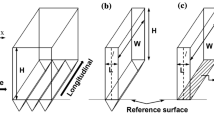Abstract
A mathematical model is presented for the problem of apparent slip arising from Stokes shear flow over a composite surface featuring mixed boundary conditions on the microscale. The surface can be composed of a bidimensional array of solid areas placed on an otherwise no-shear surface corresponding to an envelope over the tops of posts, or no-shear areas placed on an otherwise solid surface corresponding to an envelope over the tops of holes. Posts and holes of circular or square cross section, and solid areas of no-slip or partial-slip types are studied. Following some previously proposed scaling laws, the effective slip length is expressed as a certain function of the solid fraction for some specific cases. More refined equations based on linear regression of the computed results are obtained for these cases. Amounts of slippage arising from these bidimensional patterns are compared with those from the one-dimensional patterns of grooves/grates. It is also shown that a larger slip length can result from an arrangement where the pitch is larger in the spanwise direction than in the streamwise direction.







Similar content being viewed by others
References
Choi CH, Westin KJA, Breuer KS (2003) Apparent slip flows in hydrophilic and hydrophobic microchannels. Phys Fluids 15: 2897–2902
Choi CH, Ulmanella U, Kim J, Ho CM, Kim CJ (2006) Effective slip and friction reduction in nanograted superhydrophobic microchannels. Phys Fluids 18:087105
Cottin-Bizonne C, Jurine S, Baudry J, Crassous J, Restagno F, Charlaix E (2002) Nanorheology: an investigation of the boundary condition at hydrophobic and hydrophilic interfaces. Eur Phys J E 9:47–53
Cottin-Bizonne C, Barrat JL, Bocquet L, Charlaix E (2003) Low-friction flows of liquid at nanopatterned interfaces. Nat Mater 2:237–240
Cottin-Bizonne C, Barentin C, Charlaix E, Bocquet L, Barrat JL (2004) Dynamics of simple liquids at heterogeneous surfaces: molecular-dynamics simulations and hydrodynamic description. Eur Phys J E 15:427–438
Davies J, Maynes D, Webb BW, Woolford B (2006) Laminar flow in a microchannel with superhydrophobic walls exhibiting transverse ribs. Phys Fluids 18:087110
Feuillebois F, Bazant MZ, Vinogradova OI (2009) Effective slip over superhydrophobic surfaces in thin channels. Phys Rev Lett 102:026001
Hendy SC, Lund NJ (2007) Effect slip boundary conditions for flows over nanoscale chemical heterogeneities. Phys Rev E 76:066313
Hendy SC, Jasperse M, Burnell J (2005) Effect of patterned slip on micro- and nanofluidic flows. Phys Rev E 72:016303
Joseph P, Cottin-Bizonne C, Benoit JM, Ybert C, Journet C, Tabeling P, Bocquet L (2006) Slippage of water past superhydrophobic carbon nanotube forests in microchannels. Phys Rev Lett 97:156104
Lauga E, Stone HA (2003) Effective slip in pressure-driven Stokes flow. J Fluid Mech 489:55–77
Lauga E, Brenner MP, Stone HA (2007) Microfluidics: the no-slip boundary condition. In: Foss J et al (eds) Springer handbook of experimental fluid mechanics. Springer, Heidelberg, pp 1219–1240
Lee C, Choi CH, Kim CJ (2008) Structured surfaces for a giant liquid slip. Phys Rev Lett 101:064501
Navier CLMH (1823) Memoire sur les lois du movement des fluids. Memoires de l’Academie Royale des Sciences de l’Institut de France VI:389–440
Neto C, Evans DR, Bonaccurso E, Butt HJ, Craig VSJ (2005) Boundary slip in Newtonian liquids: a review of experimental studies. Rep Prog Phys 68:2859–2897
Ng CO, Wang CY (2009) Stokes shear flow over a grating: implications for superhydrophobic slip. Phys Fluids 21:013602
Ou J, Rothstein JP (2005) Direct velocity measurements of the flow past drag-reducing ultrahydrophobic surfaces. Phys Fluids 17:103606
Philip JR (1972) Flows satisfying mixed no-slip and no-shear conditions. Z Angew Math Phys 23:353–372
Priezjev NV, Troian SM (2006) Influence of periodic wall roughness on the slip behavior at liquid/solid interfaces: molecular-scale simulations versus continuum predictions. J Fluid Mech 554:25–46
Priezjev NV, Darhuber AA, Troian SM (2005) Slip behavior in liquid films on surfaces of patterned wettability: comparison between continuum and molecular dynamics simulations. Phys Rev E 71:041608
Sbragaglia M, Prosperetti A (2007a) A note on the effective slip properties for microchannel flows with ultrahydrophobic surfaces. Phys Fluids 19:043603
Sbragaglia M, Prosperetti A (2007b) Effective velocity boundary condition at a mixed slip surface. J Fluid Mech 578:435–451
Tretheway DC, Meinhart CD (2002) Apparent fluid slip at hydrophobic microchannel walls. Phys Fluids 14:L9–L12
Wang CY (2003) Flow over a surface with parallel grooves. Phys Fluids 15:1114–1121
Ybert C, Barentin C, Cottin-Bizonne C, Joseph P, Bocquet L (2007) Achieving large slip with superhydrophobic surfaces: scaling laws for generic geometries. Phys Fluids 19:123601
Zhang J, Kwok DY (2004) Apparent slip over a solid-liquid interface with a no-slip boundary condition. Phys Rev E 70:056701
Zhang X, Shi F, Niu J, Jiang Y, Wang Z (2008) Superhydrophobic surfaces: from structural control to functional application. J Mater Chem 18:621–633
Zhu Y, Granick S (2001) Rate-dependent slip of Newtonian liquid at smooth surfaces. Phys Rev Lett 87:096105
Zhu Y, Granick S (2002) Limits of the hydrodynamic no-slip boundary condition. Phys Rev Lett 88(10):106102
Acknowledgments
The authors have benefitted from personal communication with Cécile Cottin-Bizonne. The work was initiated by the second author when he was a William Mong Visiting Research Fellow associating with the first author in May, 2008. The financial support by the William M.W. Mong Engineering Research Fund of the University of Hong Kong is gratefully acknowledged. The work was also supported by the University of Hong Kong through the Small Project Funding Scheme under Project Code 200807176081.
Author information
Authors and Affiliations
Corresponding author
Rights and permissions
About this article
Cite this article
Ng, CO., Wang, C.Y. Apparent slip arising from Stokes shear flow over a bidimensional patterned surface. Microfluid Nanofluid 8, 361–371 (2010). https://doi.org/10.1007/s10404-009-0466-x
Received:
Accepted:
Published:
Issue Date:
DOI: https://doi.org/10.1007/s10404-009-0466-x



